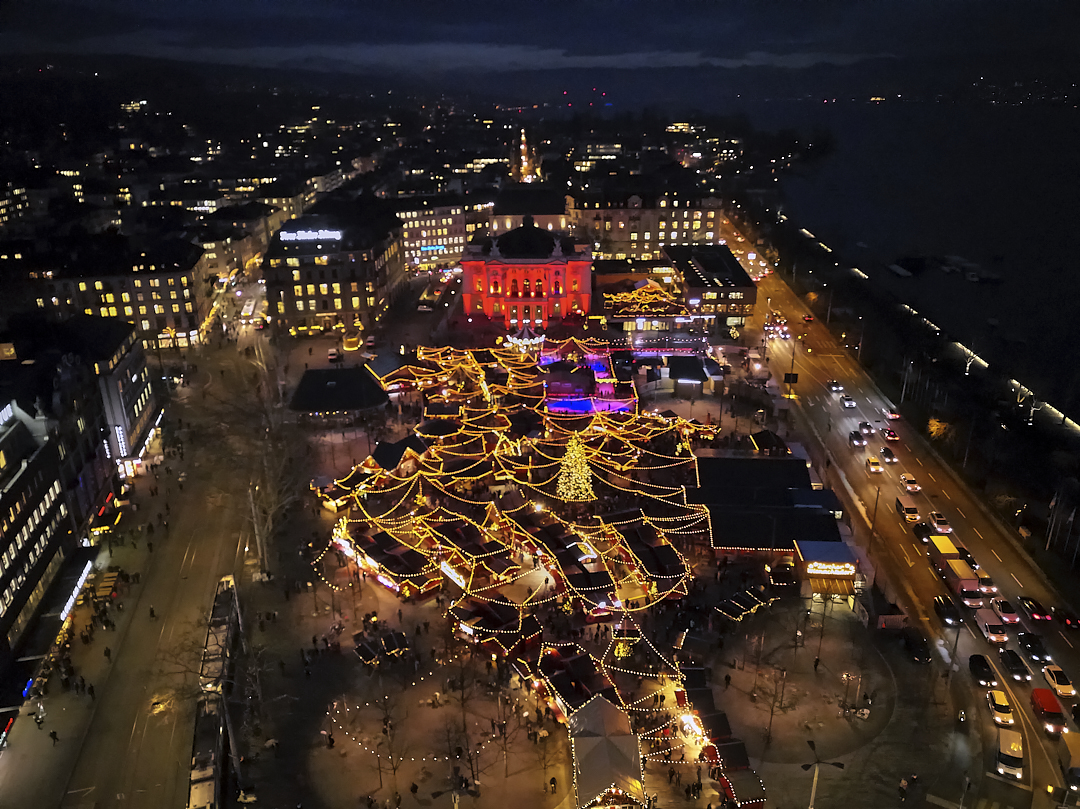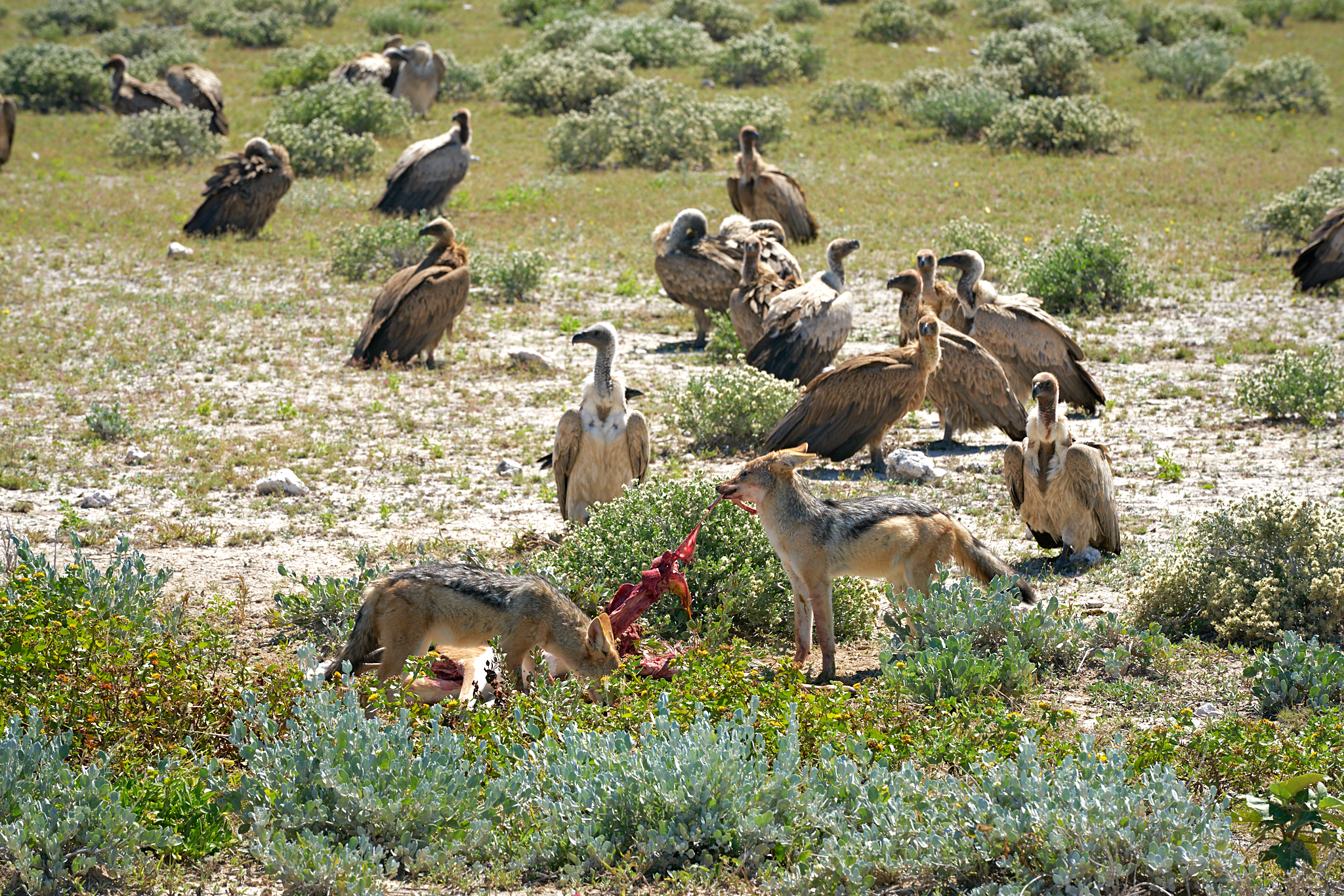Jackals and Hide
Namibia Day 11 began with a morning game drive, our first at Etosha National Park. Soon into the drive we came across a fresh kill, a springbok that had been taken down recently by presumably a cheetah. By the time we arrived, the cheetah had eaten its fill and moved on, leaving the remains for the scavengers. What ensued appeared as somewhat of a survival “dance” between the jackals and the vultures as they repeatedly parried each other for a chance to feed.
Click on the image below to view a short video of the encounter. Caution: Gory! Also, please change quality to 1080p (auto is 720 ) and view full screen!
Damaraland to Etosha, Namibia
Day 10 brought a drive out of the wild and into “civilization”. We were headed to Etosha National Park (with showers and beds), a 22,270 sq km/8,600 sq mi park which gets its name from the Etosha Pan, a salt pan which covers a quarter of the total area of the park and is so large that it is identifiable from space. Our drive to the park took us through scattered Damara villages, where farmers who subsist on herding cattle, sheep, and goats still live primarily in simple homes constructed from dung and termite mud (collected from MASSIVE termite hills) spread on a wooden frame.
Massive termite hills were scattered throughout the countryside.
Himba Women out for a stroll
Springbok “pronking”
 Kori Bustard
Kori Bustard
Milky Way over Damaraland, Namibia
Night 9 brought a goodnight and goodbye to the Damaraland (Palmweg) Concession in north-western Namibia, bringing to a close the most primitive wild camping portion of the tour. From here we head back to “civilization” in the form of Etosha National Park.
Click on photo to view an enlarged 10 panel shot of Milky Way taken from the edge of our campsite.
Exploring the Wilds of Damaraland, Namibia
Namibia Days 8 and 9 were spent exploring the massive Damaraland (Palmweg) Concession in north-western Namibia. Daily sunrise departures from our camp into the concession provided the best opportunity to enjoy the cool mornings and experience the wildlife as they completed their nighttime activities and began to settle in and take cover from the approaching scorching sun and high temperatures. Our afternoons were spent taking cover as well, mostly resting/reading and playing games in the shade at camp. Late afternoon and evenings consisted of additional drives to explore the surroundings and/or gin and tonic “sundowners” as the sun dipped beneath the African horizon.
Rhinoceros rubbing stone, which has been polished to a shine over the centuries by Rhinos scratching themselves.
Black-backed jackal
Baking bread in a cast iron pot over coals, a nightly ritual.
Oryx
Spotted Hyena
Creepy to think that if we stepped out of the vehicle these guys would tear us to shreds.
Rüppell’s Bustard
Welwitschia (Welwitschia mirabilis), the “National” plant of Namibia and endemic to the Namib Desert. Each plant produces only two leaves, which split into many segments as a result of the leaves being whipped by the wind. The largest plants are over 1500 years old.
Rainbow Sunset Over Palmweg Concession in Damaraland, Namibia
The long day 7 drive through the concession area was a slow, difficult, and at times uncomfortable (very steep terrain mixed with heavy rains) journey. As we arrived and searched out a campsite, the clouds began to clear and we were treated to a spectacularly beautiful double rainbow sunset over the camp. We were now as far out of touch from the rest of the modern civilized world as I have ever been. Over dinner our guide Sasha described the “lion” protocol for the camp (imagine him telling us this at night as light from the small fire flickered on half of his face): Never leave your tent alone at night. Need to pee? Take the bucket from outside your tent door into your tent, pee, put the bucket back outside of the tent. Need to do a #2? Wake the three men up and walk as a group to the makeshift toilet as you scan the surroundings with headlamps for reflective “eyes” around camp. Hear something at night creeping outside your tent? Don’t move, make a noise, or turn on your light. Do not call for anyone. Follow these rules, and you likely will not get eaten. We all slept great after that. And for the record, we did hear some hyenas not too far from camp as we were falling asleep.
This is my favorite photo from the entire trip. Click to see it in full resolution!
Into the Wilds of Damara Concession D7
Day 7 was when the adventure really stepped it up a notch. We were now headed out for three nights of wild camping in the Damaraland (Palmweg) Concession, a massive, roughly 5,500 km2 /2,200 mile2 conservation area in north-western Namibia. This open and wild region is the home to a large variety of species, including lion, elephants, mountain zebra, giraffe, and nearly 70% of the world’s free roaming black rhinos. Traveling and camping in the concession would allow us to experience these animals in their true open and untamed native habitat, unlike what we would later experience in the more commercial National Parks and Reserves. A long and arduous drive on little-used uneven roads, at times through torrential downpours, was worth the surprise we had waiting for us when the rains stopped and we arrived at our remote campsite (see next post!).
Two male Greater Kudo

Erongo Mountains to the Damaralands D6
The Day 6 Namibian agenda called for us to drive out from the Erongo mountains and head into the scenic Damaraland, a massive, untamed, and ruggedly beautiful region in the north-central part of Namibia which is home to one of the oldest nations in cultures in Namibia, the Damara people. Our Damaraland landscape starts with open plains and grasslands, granite hills and deep gorges, but changes dramatically to endless sandy wastelands. Somehow, though, the Damaraland is able to sustain a wide-ranging variety of animals which have all adapted to survive in this harsh and almost waterless desert. Two notable sites along the way were The Brandenburg aka “Fire Mountain”, Namibia’s highest mountain, as well as a tour of the San (Bushman) rock art in Twyfelfontein, a site that has been inhabited for 6,000 years and was used for a place of worship and a site to conduct shamist rituals. Throughout the rituals, at least 2,500 items of rock carvings have been created, and as one of the largest concentrations of rock art in Africa, has been designated an UNESCO World Heritage Site. Click to enlarge.
Himba woman in traditional clothing
The Brandberg ‘Fire Mountain’, from the effect created by the setting of the sun on its western face, which causes it to glow red like molten metal.
Twyfelfontein, one of the most extensive galleries of rock art in Africa.
Springbok grazing at dusk (one of my favorite pics from the trip)
Welcome to Aabadi campsite, guys!
Sunset over the Damaraland

Sundowner at Bulls’s Party, Namibia D5
Our second hike on day 5 sent us straight into a rainstorm as it rumbled towards our afternoon sundowner (happy hour) destination, Bull’s Party rock formation. Bull’s Party formation stems from regional volcanic activity dating back 110-130 million years, followed by erosion of the earth’s surface, which resulted in massive granite blocks being exposed throughout the area. Millions of years of extreme day/night temperature fluctuations caused the blocks to chip off and form rounded boulders, which rolled down into the valley. The formation gets its name from the belief that the boulders resemble a group of bulls facing each other.
We enjoyed our anti-malarial Gin and tonics under cover of the massive granite boulders as the sky opened up and torrential rains created streams and waterfalls where seconds earlier there were none. The Gin Gods were smiling down on us though… for the rains ended as abruptly as they began, and, as the sun set below the clouds, our surroundings were illuminated by an unearthly yellow-orange hue. As we left the protection of the rocks and headed back to camp, the intense colors made it feel as though we were walking across a Martian landscape. As the eerie colors faded, the clouds gave way to the last rays of the sun and a magical perfect double rainbow over the Elephant Head cliff formation. As always, click to enlarge.
Baboons taking shelter from the approaching storm
Bull’s Party Panorama
Taking our medicine: anti-malarial Gin and tonics
Walking on Mars
Elephant Head cliff formation
Nightmares
 Have you ever had one of those REALLY scary nightmares that you were certain was not a dream?
Have you ever had one of those REALLY scary nightmares that you were certain was not a dream?
Ponte Vecchio Bridge, Florence (Firenze) Italy
First, I want tho say that IT’S GREAT to be back. I have been “offline” for quite some time and have neglected this blog that I had come to enjoy so much. I had some pesky cervical spine discs that decided to herniate over the years, and finally they got the best of me. Pretty much anything, even computer time, became an unbearable “pain on the neck” (and back, shoulder, arm, and hand). Also, carrying a bag as light as a camera bag was too much. The offending discs have since been removed, and I now have three fused vertebrae in my neck to show for it all! I just got clearance to carry more that a few kg, so hopefully carrying the camera will keep me motivated to pick up again with the blog.
This is a shot of the Ponte Veccio Bridge over the River Arno in Firenze (Florence) Italy. My wife and I visited for a few days last summer, and had a fantastically fun and romantic trip to the “Cradle of the Renaissance “. As Rick Steve’s says, Florence is a “Super Market Sweep”, and the groceries are the best Renaissance art in Europe! (and home of Italy’s best gelato! ). I was most focused on a tour of as many Michelangelo’s works as I could see, which Florence hosts many.
This is an HDR that I created from one source image. Three copies were created at 2 f-stops intervals, merged with Photomatix, and tuned in Aperture.
Portrait Lighting for Photography
One of the aspects of photography that I know very little about is lighting. I recently purchased a really nice flashgun for my camera, the Nikon SB700. At first I had a little buyers remorse after spending so much $$ on a flash, but the more I read about it and especially USE IT, the more I really love it. It has already made a difference in my shots, even in the limited time that I have played with it.
So now that I have this awesome flash, it is time to pour through YouTube and REALLY learn how to use it . In doing so, I have picked up quite a few pointers on lighting in general, especially basic theory and layout for simple portrait lighting. I came across this great instructional video on portrait lighting basics by TheSlantedLens, and thought that I would pass it on to the blog-o-spere. In the video, Jay P. Margan demonstrates 5 different types of Portrait lighting:
- Rembrant Light
- Split Light
- Broad Light
- Butterfly Light
- Loop Light
Take notes and let him know if u like it!
I will try to post some shots using the new flash soon, maybe even some attempts at portrait lighting!
Portrait Lighting for Photography and Video! – YouTube.






























































